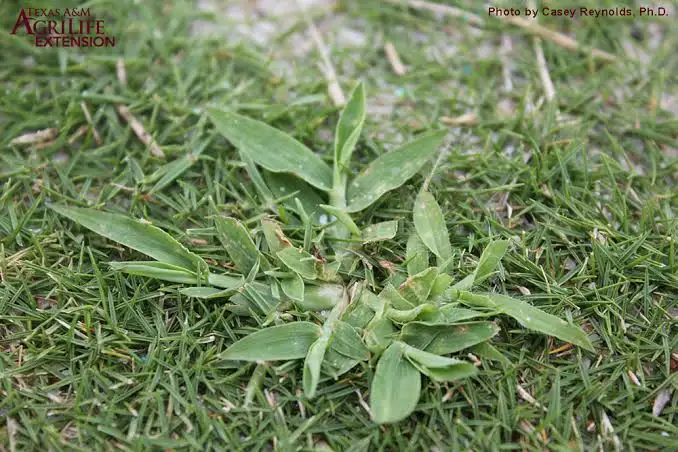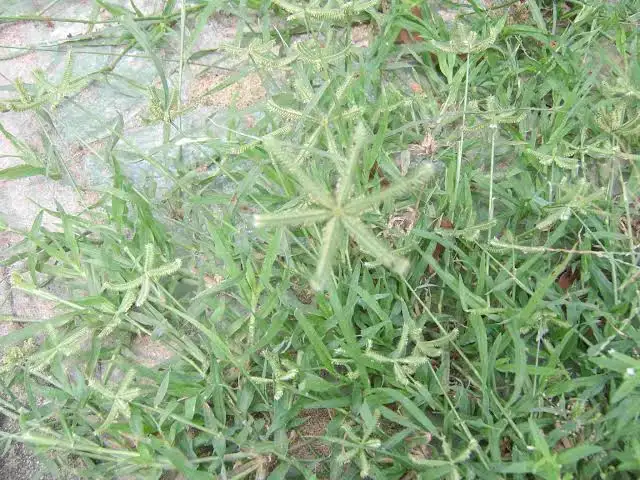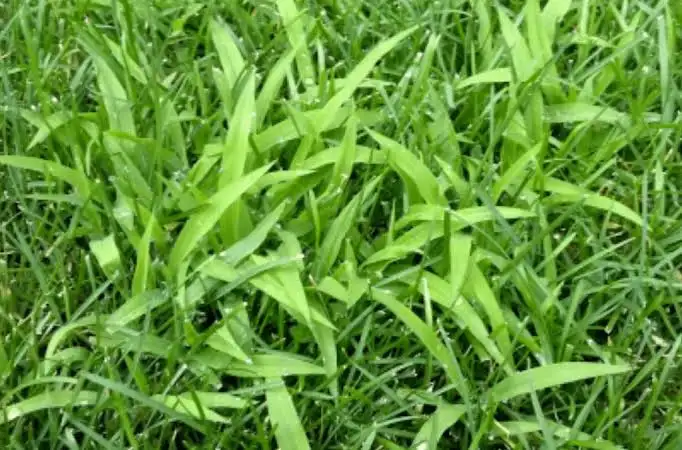Crabgrass sometimes grows upright but typically grows in a flattened, prostrate habit. It grows in patches, producing branched stems that spread outward to form thick mats that choke out other grasses. Roots grow from nodes on the stems. Crabgrass blades are coarsely textured, are yellowish-green and grow about 1 to 8 inches long. The sheath and blades of large crabgrass (sometimes called hairy crabgrass) are covered with dense hairs.
Crabgrass is an invasive weed that grows rapidly in favorable conditions. It tolerates poor soils and dry conditions and tends to grow prolifically in poorly maintained or unhealthy lawns. Crabgrass grows throughout the warm, summer months, producing thousands of seeds before dying in fall. Seeds last through the winter and germinate the following spring when temperatures rise above 55 degrees Fahrenheit.
- Smooth Crabgrass
- Hairy crabgrass
- Asian crabgrass
- Southern crabgrass
- Blanket Crabgrass
- Egyptian Crabgrass
- Carolina Cabgrass
- Indian Cabgrass
- Blue serangoon grass
- Naked Cabgrass
- Comb Finger Grass
- Cotton Panic Grass
Smooth crabgrass

Smooth Crabgrass can be identified as a low-growing annual grass. Its ligule is tall and rounded, and its collar is broad and sparsely hairy. It has sheaths that are compressed, smooth and generally tinged purple in color. The blades are sparsely hairy near the ligule, sharp and pointed. Smooth Crabgrass spreads by seeds in bunch formations and has a light yellowish-green appearance, setting this grassy weed apart from many types of desired grass.
Smooth crabgrass can tolerate very dry, poor quality soils and is found in multiple cropping systems ranging from agronomics, to landscape, to horticulture, to vegetable gardens, along with both cool and warm season lawns.
Hairy Crabgrass

Hairy Crabgrass can be described as a tufted to horizontally growing summer annual grassy weed that roots at the lower nodes. Its ligule is tall with jagged edges, and its collar is broad and prominent with long hairs at the edges. Hairy Crabgrass also features sheaths that are compressed and flat, with hairy blades that are sharply pointed.
Hairy Crabgrass is a frequent invader of lawns, fields and other landscaping. Once established, good lawn-mowing practices can help prevent it from spreading farther, but may not be enough to stomp this grassy weed out. It is used as animal fodder, and the seeds are edible and have been used as a grain in Germany and especially Poland, where it is sometimes cultivated.
Also Read: Different Types of Fern Plants To Grow At Home
Asian Crabgrass

Asian Crabgrass is a summer annual grassy weed that is also known as Tropical Crabgrass or by its scientific name, Digitaria bicornis. It is characterized by bending and rooting at the nodes. Its blades are usually measure over 2 inches long, and it has a visible, membranous ligule at the base of its leaf blades.
Tropical Crabgrass produces seeds during mid-summer until the first frost. The seeds of this problematic lawn weed lie dormant over the winter and germinate the follow spring. Tropical Crabgrass differs from Large and Southern Crabgrass in that its seed head branches all join the stem at the same point.
Asian Crabgrass is quickly outcompeted by healthy lawn grass because, as an annual plant, Asian crabgrass dies off in autumn and needs open conditions for its germination the following spring.
Southern Crabgrass

Digitaria ciliaris, Southern crabgrass is a tough plant, believed to have originated in Asia but now found all over the tropical belt of the planet, as well as in many temperate regions of both hemispheres. This grass is an invasive species considered an aggressive weed in certain countries.
This grass is an annual plant that can grow up to 1 m tall, but is usually much shorter. The roots are at the nodes and the stems produce runners that allow the plant to grow fast forming scruffy-looking patches about 1 m across and half a metre in height. The leaves are linear to linear-ovate narrowing at the tip to 15 centimeters long. The inflorescence is at the top of a long stem, usually much taller than the leaves, with two to nine 5–10 cm long sub-digitate racemes.
Blanket Crabgrass

Blanket Crabgrass is a mat-forming annual grassy weed with creeping stolons. It is also known as Dwarf Crabgrass or by its scientific name, Digitaria serotina. Its leaves are crowded on the creeping stems, and its blades are very short—only about 1 inch long. Blanket Crabgrass has hairy sheaths and hairy leaf blades, distinguishing it from other forms of Crabgrass. Blanket Crabgrass reproduces by seeds and stolons and can become a year-round lawn weed in climates without heavy frost.
Also Read: Different Types of Ornamental And Evergreen Grasses
Egyptian Crabgrass

Egyptian Crabgrass is a summer annual grassy weed that is also known as Crowfootgrass, Durban Crowfootgrass is a tufted summer annual grassy weed that is yellow to green in color. This crabgrass variety spreads and roots at the lower nodes. Its ligule is short with hairs across the top, and its sheaths are smooth and compressed, with some hairs near the ligule.
The leaves form with a row of hairs extending outward from the margin along the lower portion of the blade. Egyptian Crabgrass also features seed head spikelets arranged on two to five “fingers” radiating from a single point—this gives the appearance of a crow’s foot, hence the name of this lawn weed: Crowfootgrass.
Carolina crabgrass

Digitaria cognata is a species of grass known by the common names fall witchgrass, Carolina crabgrass, and mountain hairgrass. This grass is a perennial without rhizomes. The roots are shallow. The erect stems grow up to 56 centimeters tall. The stem bases are tough and hairy.
The leaves are up to 12.6 centimeters long. They are narrow, with “one side wavy, and the other smooth”. The inflorescence is a purple-tinged panicle with single-flowered spikelets. This grass provides graze for livestock and wild ungulates, and birds eat the seeds.
India crabgrass

India crabgrass (Digitaria longiflora) is a mat-forming summer annual. The leaf blades are quite short, usually about 1 inch long. India crabgrass differs from blanket crabgrass in that the sheaths and blades are smooth. India crabgrass is usually found in dry sites, whereas blanket crabgrass favors moist to wet sites.
Also Read: Different Varieties of Bermuda Grass For Your Lawn
Blue serangoon grass

Digitaria didactyla also known by the common names, Queensland blue couch or blue serangoon grass, this species is a mat-forming perennial grass with rhizomes and stolons. The stems can reach up to 65 centimeters long, but are generally 12 to 25 centimeters, with a creeping form, extending along the ground and rooting at the stem nodes. The narrow leaf blades are usually hairless, and green to blue-green in color.
The inflorescence has 2 to 4 thin, finger-like branches, lined with pairs of small spikelets each under 3 millimeters long. The grass can grow into a dense, leafy stand up to 20 centimeters tall unless it is kept down, for example, with grazing.
How to Kill Crabgrass Around Plants
Manual Control
- Use a small garden shovel to dig the crabgrass out of the ground near plants. Place the crabgrass in a plastic bag, and fill in the hole where the weed was removed with the surrounding soil.
- Apply the corn gluten meal around the plants with your gloved hands. Use at a ratio of 3 pounds of corn gluten meal for every 100 square feet of bed.
- Use your hand or a small garden shovel to carefully incorporate corn gluten meal into the soil. Dampen the soil lightly with a water hose set on mist. Repeat the treatment every 60 days to prevent crabgrass seeds from germinating.
Also Read: How To Grow And Care For Bermuda Grass
Chemical Control
- Select a ready-to-use herbicide formulated to kill postemergent crabgrass. One such product contains the active ingredient ammoniated soap of fatty acids.
- Wait until a calm, dry day when rain is not in the forecast for at least 24 hours. Wear safety goggles and rubber gloves.
- Apply the herbicide exactly as instructed on the product’s label. Hold a piece of cardboard in front of desirable plants within reach of the crabgrass. The cardboard acts as a protective shield preventing the herbicide from coming in contact with the desirable plants.
- Spray the crabgrass before it reaches 5 inches tall thoroughly with the herbicide. Ensure that the entire plant is covered with the solution but not to the point of runoff.
- Reapply the herbicide in the same manner once every two to three weeks as needed. Store the unused herbicide in the original container in an area out of the reach of children and animals, and away from open flames.